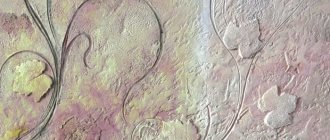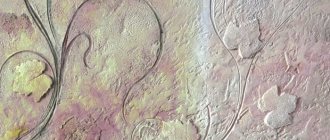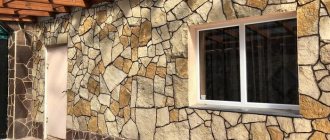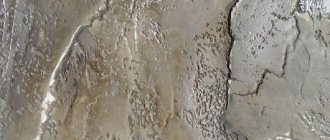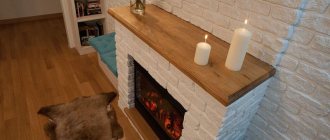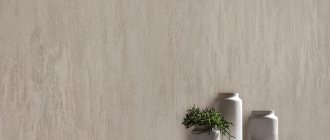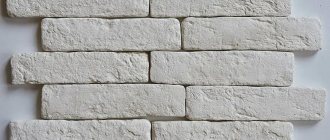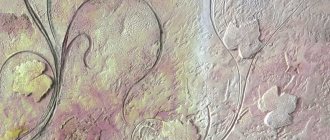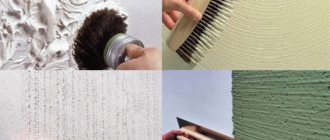Performance characteristics of decorative plaster
Decorative finishing material is a special composition that differs from those analogues used for simple leveling. Its peculiarity is that the product is used for the final stage of surface finishing. Particles of marble, sand, granite, and quartz are added to it. There are also antiseptic additives, which prevents the development of harmful microorganisms. At the same time, there is not a single dangerous or toxic substance here. In other words, the material is clean from an environmental point of view.
Decorative plaster provides the coating with sound insulation and fire resistance. The applied mixture also receives other qualities:
- ability to withstand temperature changes;
- resistance to moisture;
- absorption of kitchen odors is eliminated;
- walls can be easily cleaned with detergents;
- the surface is not afraid of exposure to grease, water, dust;
- resistance to mechanical damage;
- exposure to sunlight does not have a harmful effect;
- the decorative appearance is preserved for a long period of operation.
Type of decorative plaster in the kitchen
Decorative cladding is universal in nature due to the fact that it adheres well to any wall made of different materials:
- concrete;
- bricks;
- drywall;
- wood;
- metal
To plaster walls with this finish, it is not necessary to have specific knowledge and skills. The mixture itself is supplied to markets in convenient packaging containers. Irregularities on the walls are masked, becoming invisible. And after applying the decorative mixture, joints and seams will completely disappear.
Advice! Picturesque mixtures can make the kitchen come alive against the backdrop of imitation of different directions - from natural stone to delicate silk flakes.
Features of working with the material
The peculiarity of the material is its high plasticity. This makes it possible to obtain various images, and by adding small stones and shells, create a panoramic picture. You can purchase dough-like or dry decorative plaster. Its technical characteristics are different, which should be kept in mind when purchasing material for decorating walls in a room.
What you should know about this material before purchasing
Decorative plaster itself is durable, wear-resistant, beautiful and effective. But if, for example, it is quite possible to hang wallpaper yourself, then applying plaster requires experience and skills. In addition, the material is more expensive than other types of finishes.
The result of wall finishing will depend on two points:
- Type, size and shape of filler.
- Application technique (movements can be vertical, horizontal, circles, in one direction or in different directions, large strokes, etc.) and tools used.
It is better to cover a kitchen in a new building with textured wallpaper with a relief surface, giving preference to non-woven or vinyl. In the first years, new houses shrink: decorative plaster quickly cracks.
What to consider when choosing a material
The final result of finishing depends on the choice of composition, texture, color.
When planning to decorate the walls in the kitchen with decorative plaster, it is important to take into account in advance the complexity of updating the interior. Dismantling plaster is a rather labor-intensive process, since it will have to be cut from the wall using a grinder or a hammer drill. You can also repaint it a new color, or putty the relief surface, and then level it for wallpaper or painting.
To make the coating last longer, decorative putty based on acrylic is selected for the kitchen. It allows the composition to withstand fluctuations in temperature and humidity, while allowing air to pass through and not becoming moldy.
Selection of color and texture
The most important factor in the aesthetics of decorative plaster is texture. The relief of the plastered surface is determined by the tools and application techniques used, as well as special fillers.
Decorative plaster imitates any texture:
- marble palace radiance;
- velvet or satin drapery;
- moonlight;
- sand dunes;
- valuable types of stone, etc.
The wide range of colors is a huge advantage of this material. The choice depends on the stylistic direction. For the kitchen, white, beige, gray, silver, and brown are most often chosen.
With the help of a competent combination of color and unusual texture, you can achieve a stunningly beautiful effect in the room.
Pros and cons of decorative plaster in the kitchen
Like all building materials, the decorative type of finishing has its own advantages and disadvantages. In the interior of a kitchen, such cladding is most appropriate due to a number of positive aspects:
- the ability to allow air to pass through, which suppresses noise and the walls can “breathe”;
- if you follow simple technology and choose high-quality material, the coating will stay firmly on the walls for several decades;
- traces of rough finishing will be reliably hidden from view;
- After applying the plaster, no seams or joints are formed, which is very critical for the kitchen. It is in these places that pollution most often accumulates;
- the material itself is environmentally friendly;
- the coating is attractive in appearance;
- even during regular cleaning, the plaster will not be erased from the walls;
- material consumption fully depends on the surface texture;
- there is wide scope for realizing your own or designer’s imagination, both amateurs and professional craftsmen.
Unfortunately, it is not without its drawbacks. The main disadvantage is that such compositions are more expensive than ordinary plaster. Applying a wet solution to metal surfaces will subsequently cause rust to form. Also, decorative plaster cannot be applied when mineral wool is used to insulate the walls. The last disadvantage is that carrying out spot renovations of the kitchen is irrational, both financially and aesthetically.
Advantages and disadvantages of plastering
There are many advantages to using decorative putty in the kitchen interior, but there are also disadvantages.
Interesting! The disadvantages arise from the type of mixture, each has its own.
| Advantages | Flaws |
| Apply to different types of surfaces (iron, wood, concrete). | The mineral type of putty may develop cracks if the building being repaired does not settle. But the cracks are simply sealed. |
| After all the operations, there are no seams left and the result is a spacious room, not divided into segments. | It costs a lot (especially silicone), and if you are not a professional you will need a lot of it. |
| There is no need to carefully level the walls before plastering. It will all level out on its own, and for the Venetian, a small relief is even welcome. | Mineral putty can only be painted in a snow-white shade. |
| The composition allows the walls to “breathe” due to the free movement of air. | Acrylic putty should not be applied over slabs because toxic substances may be released. |
| If the recipe contains minerals, then they do not allow mold, bacteria and fungi to multiply. | Before using the silicate type, it is necessary to prime the walls with a special solution using a complex technique. |
| Long service life and strong resistance to various negative influences. | |
| Ease of restoration. If a small part is damaged, there is no need to putty the entire surface again. |
Despite the large number of disadvantages, there are many more advantages. An additional advantage is its relevance in different designs, which is why it is in demand in kitchen decoration.
Types of material by structure
Which decorative plaster to choose for the kitchen? Based on the base material, texture, and appearance, the finishing cladding is divided into several types. To ensure that the composition corresponds to the ecological grade, most manufacturers use only natural as well as synthetic raw materials. Each type has its own characteristics.
Based on the structure of the decorative material, there are three types of plaster:
- textured;
- structural;
- Venetian
Textured
Structural
Venetian
Textured decorative plaster forms a rough coating on the surface of the walls. This allows you to do without the puttying procedure.
Structural cladding is of a similar nature and after its application the walls acquire a characteristic relief. This type of finishing is in harmony with loft or high-tech rooms. For Provence and classics, such a coating is not suitable and will only spoil the interior of the kitchen.
The Venetian version is the most expensive, which is demanding on the evenness of the walls - ideal parameters are needed.
Combining Venetian plaster with other materials in kitchen design
Venetian plaster is easily combined with other finishing materials. Designers offer different combinations in search of an attractive and unique design.
The most popular combination ideas for kitchen interiors:
- Combination with wallpaper. The combination requires the use of moldings and decorative strips that smooth the transition between the two materials.
- Combination of matte plaster with glossy tiles.
- Combination with natural stone.
Venetian plaster in the kitchen interior is used only on one wall. Textured plaster is used on any surface, be it a backsplash, island, ceiling or floor.
Apron design
Relevance of plastering a kitchen apron
The excellent performance characteristics of some types of plaster make it an ideal option for finishing a kitchen apron. This is a fairly universal design. A bright coating can serve as an accent solution in the interior of both a small and spacious kitchen.
Venetian plaster looks especially impressive with the addition of natural marble and granite chips. In addition to aesthetic beauty, this coating perfectly hides any unevenness in the walls.
Types of material by composition
Depending on the base used for making the plaster mixture, there are 4 types that are suitable for kitchen finishing work. Moreover, the dimensions of the room do not play a role.
Mineral
The composition is made on the basis of lime hydrate, white cement, marble (or granite) chips. The surface of the walls is textured and at the same time durable and elastic.
This is the cheapest option, and therefore requires subsequent painting (or adding color to the solution itself). The surface should be painted no earlier than 30 days after applying the finishing work. Service life varies from 10 to 15 years.
Mineral decorative plaster for the kitchen
Silicate
Plaster is made from liquid glass. The finished material is resistant to moisture and mechanical damage. Even a nearby hob or stove will not have a negative impact on the walls. This type of coating does not attract dust, which is excellent. However, to use it effectively, it requires the use of a special primer. Service life is up to 50 years.
Silicone
The production of silicone cladding is based on natural resins. The plasticity of the material makes it easy to apply it to the surface of the walls. Plaster can be used not only indoors - it is also suitable for facade work.
Types and methods of finishing
Manufacturers offer a wide range of finishing decorative plasters, which differ in the type, size and shape of the filler. How the coating will look on the walls also depends on the application technique and what tools the master uses.
By base type
Based on the type of binding element, the coating is divided into four types: acrylic, mineral, silicone and silicate. Each variety has its pros and cons.
Acrylic decorative plaster in the kitchen is a universal elastic mixture made on the basis of acrylic resin. This is a material that:
- dries quickly;
- easy to clean from any dirt, including grease;
- painted in any color;
- withstands high levels of humidity and frequent temperature changes;
- serves up to 15 years.
At the same time, this type of plaster easily ignites, cracks under the influence of ultraviolet radiation, and also does not have good vapor permeability.
Mineral decorative plaster is both the most budget-friendly and the most environmentally friendly type of finishing. It is made from lime, cement, mineral particles, stone chips and clay. The coating is not afraid of moisture and frost, resistant to abrasion, but short-lived, service life is maximum 10 years.
Silicone mixture is the best option for interior decoration of the walls of apartments and private houses, but is less in demand due to its high price. Material properties:
- breathability;
- strength;
- ease of care;
- water resistance;
- resistance to fading;
- good grip on any surface.
Silicate is the most durable of the four types due to the fact that the composition is based on liquid potassium glass. The material repels dirt and water and stays on the surface for up to 20 years. But this composition is dangerous to human health, so it is not used for plastering walls in the kitchen.
By design and application technique
A variety of designs, patterns and textures for any style
Application techniques can be vertical, horizontal, circles, in one direction or in different directions, large strokes, etc.
The base layer of plaster coating is usually applied to the wall with a standard roller or an ordinary trowel. Next, a relief pattern is created on the decorative layer. To do this, they use metal smoothers, a large-textured natural sea sponge, a tampon applicator, etc. As a result, from the same material, with skill, you can get such a diverse texture that no one will guess about the same origin.
By appearance
Decorative plaster is also distinguished by texture, that is, by the appearance of the final finishing result. The additives determine how granular, grooved or embossed the plaster on the wall will be.
Main invoice options:
- Structural: lamb, fur coat, terrazite.
- Bark beetle Looks good in country style, Provence, shabby chic, Mediterranean style, appropriate in modern and classic interiors, loft style.
- Venetian - it simply perfectly imitates stone due to the presence of small crumbs of natural marble, onyx, granite, quartz, travertine, jasper, malachite and other types of natural stones. Suitable for kitchens in classic, art deco, modern and minimalist styles.
- Silk is an excellent solution for the kitchen. The composition contains acrylic dispersion and a special filler. After hardening, it forms a beautiful shimmering surface with a velvety texture and an original glossy shine.
- Marseille wax - suitable for Provence and country interiors.
- Sgraffito. Consists of several multi-colored layers with a scratched pattern on top. Craftsmen apply the coating to the wall in an even layer, and then scratch a design or ornament onto it using a stencil.
- Craquelure is an unusual effect of a cracked, aged surface. Suitable for any substrate: concrete, brick, wood, drywall.
- Latex plastic is a composition with a smooth, slightly glossy texture that imitates marble or other stone. The material is moisture resistant and elastic. The pattern is obtained using tinting.
- Wet silk resembles the shimmer of flowing fabric.
- Sea Breeze is a rough coating with fine-grained sand and pearl dust in its composition.
Different compositions create textures with different patterns: wave, dune, furrows, shading. They are made using sponges, rollers, brushes, toothed tools, and film.
Choice of color and pattern
The range of decorative cladding is wide, which also applies to the palette - it is also diverse. The modern market provides opportunities to select the appropriate option for your kitchen space. It is important to consider which shade is most suitable for a particular interior style.
The most popular shade in the “hot” home area is white. The use of an imitation brick wall looks relevant in a Scandinavian kitchen.
The beige color scheme is popular with many professional designers. Just look at the cost of an apron decorated with Venetian plaster! And this area in any interior becomes the highlight of the kitchen interior, regardless of the style of the kitchen space.
For minimalism or loft, a suitable shade is a black palette. You should avoid too pronounced relief, but also give preference to an expressive coating. In this case, the black color will show itself in all its glory.
White decorative plaster
Beige decorative plaster
Black decorative plaster
Any modern kitchen will suit a green palette. This is a winning design solution for creating a delicate and fresh interior.
It is not necessary to completely cover all the walls with plaster - some kind of accent is enough. Let this be the dining area.
In spacious rooms, shades such as purple, lilac, and pink are appropriate. The kitchen interior has soft and delicate outlines.
A gray and concrete palette will not only emphasize the beauty of the loft, it is also a good design for a high-tech, modern style kitchen.
Green decorative plaster
Purple decorative plaster
Gray decorative plaster
Blue and turquoise tones are most suitable for Provence, Mediterranean interiors and country style. The main thing is to choose the right solution that will be in harmony with the rest of the room’s design.
A bright range of yellow or red finishing material will be the best choice for any style.
Yellow decorative plaster
Red decorative plaster
Blue decorative plaster
The drawing deserves special attention. The kitchen room will be significantly enlivened with the help of designer compositions. For example, imitation of wall stucco or frescoes looks great. However, it is difficult to do all this on your own, and therefore you should turn to real masters.
Styles and design
A wide range of decorative plaster allows you to implement variations of design solutions at your own discretion. Among the successful examples are the following options:
- concrete. Special compounds are used here - microcement or decorative art concrete. Traditional cement mortar will also work. As for the shades for the kitchen, it can be beige or white. In some cases, a rusty palette looks appropriate;
- marble kitchen. This style is created with smooth plaster or a mixture with veins. The shades of the cladding will provide the appearance of natural stone;
- silk interior. The effect of wet fabric on the walls is achieved by using a mixture containing a glossy or metallic pigment;
- brick kitchen. To create the interior, a coarse mineral-based mixture is used. The mortar is convenient for forming brickwork;
- colored interior. The result is achieved by using several shades, which ultimately creates a worn effect on the walls. Otherwise, a two-color pattern looks good.
Decorative plaster concrete
Marble plaster
Brick kitchen
Colored plaster
Plaster silk
The choice of a specific solution depends on your own preferences and financial capabilities.
What to consider when choosing a material
Decorative cladding harmonizes well with other finishing options. However, in order to improve the functionality of the kitchen space, it is important to consider a number of factors:
- Vapor permeability. For some materials this is an important factor and should not be discounted. For “breathable” walls made of aerated blocks, you need a material with good vapor permeability. In relation to brick and concrete walls of structures, the parameter does not play a role.
- Moisture resistance. Since the humidity level in the kitchen changes regularly, this indicator is very important. It is necessary to give preference to moisture-resistant compounds.
- Practicality. The finished coating should be easy to clean. And the kitchen is exactly the place where, in addition to fumes, there are also fats that settle on the walls. Even a working hood is no guarantee.
- Manufacturer and cost. You definitely shouldn’t choose too cheap options from little-known companies, as this is a waste of money. Due to the specific temperature and humidity conditions of the kitchen, it is better not to skimp on materials. Brands such as Caparol, Kreisel, Perel, De Luxe and many others will bring more benefits, although they are not cheap.
Regarding the cost, in addition to the manufacturer and sellers, this is influenced by the shade of the mixture and the size of the grains.
Shades of decorative plaster for the kitchen
Manufacturers
Prices for types of decorative finishing materials vary widely. It all depends on the specific manufacturer and the composition of their product. Dry mixes are always cheaper than ready-to-use plaster. The most popular manufacturers are these brands:
- Novacolor;
- Srucco;
- Veneziano;
- Knauf;
- Ceresit;
- Weber-Vetonit;
- Catteau;
- Terraco;
- Art Deco;
- "Bolars";
- "Walls".
Manufacturers from Germany, France, Sweden, Russia, Italy are listed here.
Consumption
Despite the fact that processing textured plaster surfaces causes certain difficulties, such a coating has no equal in beauty. The amount of material depends on the thickness of the layer, as well as on the size of the fraction. For convenience, everything is summarized in the table below.
| Decorative Product Type | Release handicap | Consumption (kg/sq.m) | Note |
| Textured | Grain 1 mm | 0,9 | |
| Grain 3-4 mm | 1,5 | ||
| Plaster with quartz chips | Powder 25 kg | From 2 to 3 | |
| Composition based on resin dispersion | Grain 1 mm | 2,5 | Sold ready to use |
| Particles 2 mm | 3 | ||
| Acrylic mixture of synthetic resins | Grain 0.7-1 mm | 1,5 | Supplied to the market in raw form |
| Grain 1.2-1.6 mm | 2 | ||
| Grain 2-2.5 mm | 2,5 | ||
| Plaster with marble chips | 10 kg bags | From 1 | Layer thickness 1-3 mm |
| Bark beetle | From 2.4 to 4, based on the dimensions of the filler. The exact calculation is individual for each brand. | ||
| Venetian mixture (marble) | From 70 to 200 g/sq.m. m. Color saturation is the main factor in the number of layers | ||
Important! Any type of decorative finishing requires pre-treatment of surfaces with a specific primer. The choice of a specific composition is influenced by the type of plaster.
Textured pattern on the wall
Preparing plaster for work
In our kitchen we used ready-made polymer decorative plaster. The grain was 1.5-2 mm, but to each their own taste. We compared it with dry ones from friends, the difference in quality is noticeable. Yes, and extra work with breeding. The bucket with the finished plaster must first be thoroughly mixed for 10-15 minutes in order to evenly distribute the grain throughout the mass. If necessary, add water to the desired consistency. The viscosity should be approximately the same as that of conventional finishing plaster. In order not to paint the walls, add colors directly to the plaster and mix until a uniform color is obtained. And in the future, small chips will not be so noticeable. We especially mix the mixture in the corners of the bucket at the bottom. During operation, the mass must be stirred occasionally to prevent the marble chips from settling.
The nuances of finishing a kitchen with decorative plaster
To ensure that decorative plaster for interior decoration does not cause difficulties in work, it is worth considering a number of features:
- Plastering will cost significantly more than using wallpaper or paints. This should be taken into account at the renovation planning stage - you should always be prepared for the fact that an additional portion may be required.
- The formation of textured patterns, as well as surfaces with deep reliefs, requires more material, in contrast to smooth plaster. For example, the consumption of acrylic mixture is on average 2.5-3 kg per m2. But here it is worth relying on the recommendations of the manufacturers, since each specific case has its own recommendations.
- To distribute the decorative mixture over the entire surface, it is permissible to make any movements - long, short, transverse, longitudinal. Everything can be done either smoothly or roughly, depending on the desired effect. One person should distribute the mixture so that the texture of the walls looks more or less uniform.
- It takes a certain time for the solution to harden - 14 days. And while the plaster is drying, you should be as careful as possible so as not to damage the plaster.
- Because the solution itself dries quite quickly and therefore the work should be done by two people. One applies the mixture to the walls, the other distributes it over the surface.
Note! To preserve the appearance of the finished decorative coating, it is advisable to treat the surface with acrylic varnish or apply protective wax. This will protect the plaster from cracking, and the coating will be shiny, which will emphasize the existing relief.
Decorative plaster from ordinary putty: proven recipes
Selecting a composition for subsequent application of relief on it is quite simple. Let's look at how to make a mixture “for a roller”, a stencil and any other device.
- We take gypsum or chalk powder (aka calcium carbonate) as a base. It will take 6500 g.
- PVA glue as a binder. You will need 800 g of it.
- CMC glue solution 5% It is diluted in water strictly according to the manufacturer's instructions. Need 2000
- A bar of 72% laundry soap as a plasticizer. Grind it on a grater and dilute it in a small amount of water to a gel-like state.
The kneading process is very simple. First we prepare the liquid. Add the powder into it in small portions and mix well. It is optimal to use a construction mixer. Let the finished paste sit for a while and stir vigorously again. The peculiarity of this variety is its long drying time. We invite you to watch a video that shows the process of texturing a homemade material.
There is an even simpler recipe, which requires any gypsum putty with additives. To increase its strength you will need PVA glue. It is added to the mixing water, after which the mixture is introduced into the liquid in parts. Proportions are observed in accordance with the manufacturer's recommendations. The finished solution can be applied in any way you like to obtain a relief surface.
Finishing gypsum putty Starateli, 20 kg
385
Buy
To obtain bark beetle type plaster, we can recommend the following mixture option:
- coarse sand, sifted and washed - 3 parts;
- finely dispersed gypsum composition with mineral additives such as “Satengips” - 3 parts;
- a mixture of gypsum with polymer additives such as “Fugenfüller” - 1 part.
Finishing gypsum putty Bergauf Fugen Gips, 25 kg
427
Buy
All components are mixed dry to a homogeneous mass, which is mixed with water and kneaded well.
Instagram @alexandro_guro
A properly prepared and applied homemade decorative mixture of putty material is not much inferior to its industrial counterpart. It is important to select its components taking into account the purpose.
How to make decorative plaster in the kitchen with your own hands
If you have a limited family budget, finishing the kitchen is easy to do yourself. Before applying decorative plaster to the walls, you need to prepare the surface to be treated. For this purpose, remove old wallpaper or paint. If there are cracks, seal them. The wall should be smooth, dry and clean.
The sequence of actions is as follows:
- Apply putty and allow time to dry.
- Now it’s time for the primer - it is advisable to choose an acrylic composition.
- When the primer has dried, you should begin applying decorative plaster. The finished coating is not painted; instead, the color is added when mixing the solution.
- It is convenient to give the coating the desired relief with a metal spatula, roller, trowel (trowel), or sponge.
- After plastering, the next final operation is the application of a special varnish for protective purposes.
Applying putty
Applying primer
Application of decorative plaster
Application of special varnish
Not every finishing material is suitable for the interior of a kitchen space. Decorative plaster has a better chance due to its characteristics. All that remains is to make the right choice and follow the technology.
How to use in the kitchen
No one forbids you to use textured plaster to finish all surfaces in the kitchen, including the ceiling. However, it is worth noting that you will soon get tired of it with its diversity and solemnity on the walls. Properly, without going overboard, by placing accents using decorative coverings, you will bring a cozy and homely atmosphere to the kitchen.
Remember that not all compounds can be applied to the apron area
What not to do:
- Cover more than one wall in the room with textured plaster. An exception is applying the material to the corner in the place where the recreation area will be located.
- Excessively contrasting decor. Remember, textured plaster should only create an accent. It looks good in warm beige tones that harmonize well with kitchen furniture or flooring.
- Using textured plaster to finish a kitchen splashback is not practical, because this work area is subject to frequent contamination during the day. And frequent washing will lead to its destruction.
If you really like to see the kitchen walls “dressed” in a textured shell, then use at least several application methods and different tones. Who knows, maybe using this technique you will create a masterpiece of design thought.
Possible difficulties
When choosing decorative plaster as a finishing material for the kitchen, you should be prepared for possible difficulties. It is worth noting the risk of cracking. The mineral composition is not highly elastic, which is why, due to a natural process (shrinkage of the building), the wall becomes covered with a pattern of cracks. The problem can be solved by repairing the damaged areas and this work may have to be done regularly.
Plaster finishing in the kitchen
Another difficulty lies in cost. This applies not only to the price of the material itself - it is difficult to create a design according to individual preference, and therefore the involvement of a master will be required. And such work is highly valued.
The use of decorative plaster makes it possible to combine the kitchen with the living room, creating a single space. Finishing decorative material can easily be used on an apron or to highlight a dining area. There are types of finishing that completely eliminate remodeling. For example, if you need to repaint Venetian plaster, you need to remove the entire top layer.
Also, craftsmen do not recommend creating a large amount of relief in the kitchen, since dirt quickly accumulates in these places. This leads to frequent cleaning. Instead of a textured apron, it is better to choose a smooth mixture. The same applies to the work area.
Did you manage to learn something new? Share it in the comments!
Reviews
Reviews about the material are mostly positive.
Elena, 35 years old, Moscow:
“I completed the finishing with plaster in the kitchen, chose neutral shades and created accents using textured mixtures. The coating lasts a long time, is not damaged, and looks aesthetically pleasing.”
Oleg, 40 years old, Kaliningrad:
“The plaster finishing was done in a loft-style kitchen. The material made it possible to reproduce the surface as concrete. Artificial aging was used in the design. The finish is spectacular and durable.”
